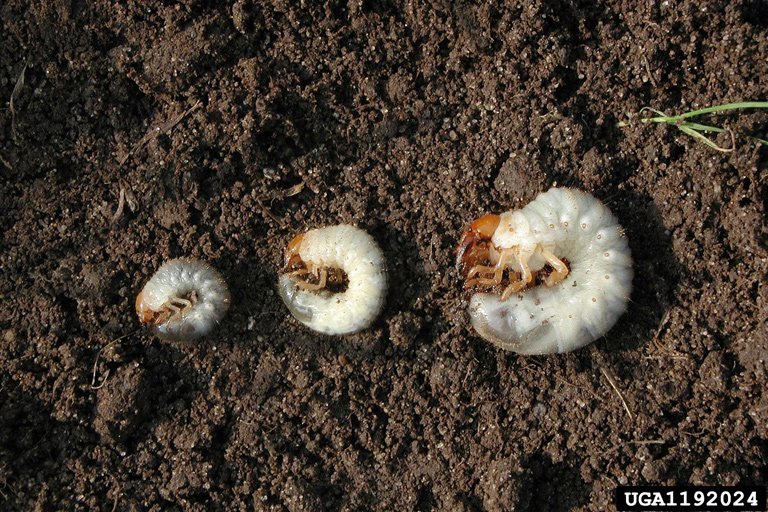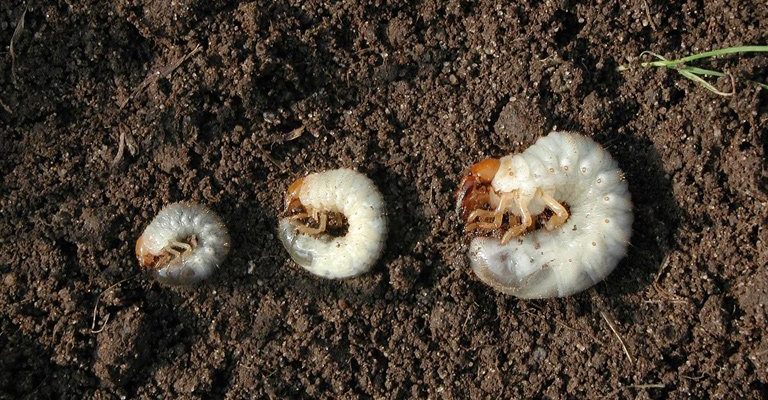
Understanding the different types of white grubs can help you approach pest control or gardening with more knowledge. After all, just like you wouldn’t try to train a Saint Bernard the same way you’d train a Chihuahua, different grubs require different strategies. So, let’s dive into this intriguing world and explore what sets these little critters apart.
What Are White Grubs?
White grubs are the larval stage of various beetle species, most notably the Japanese beetle, May beetles, and various June beetles. Typically, they’re shaped like a “C” when they’re resting, and they have soft, white bodies with a brown head. They live underground, munching on plant roots, which can be a real headache for gardeners and lawn enthusiasts.
The life cycle of a white grub starts when adult beetles lay eggs in the soil. Once the eggs hatch, the larvae emerge and start to feed. Depending on the species, they can spend several months to a couple of years in this grub stage, causing damage along the way. So, if you spot one in your garden next time, think of it as an indicator of what’s going on beneath the surface.
Common Types of White Grubs
Not all white grubs are created equal. Some of the most common types include:
- Japanese Beetle Grubs: These are probably the most notorious. They’re large, plump, and can do a number on your lawn by feeding on the roots.
- May Beetle Grubs: Usually found in late spring, these grubs also love to feast on roots, particularly of grass.
- Green June Beetle Grubs: These grubs are less common but can still be a nuisance, especially for fruit and vegetable growers.
Each type has its unique characteristics, habitat preferences, and growth patterns. Knowing which grub you’re dealing with can inform how you tackle them—whether using traps, insecticides, or natural methods.
Life Cycle of White Grubs
To understand white grubs, it helps to know their life cycle. They typically go through four stages: egg, larva (the grub stage), pupa, and adult beetle.
1. **Egg Stage:** Adult beetles lay eggs in moist soil during the summer. This usually happens between late June and early July.
2. **Larva Stage:** The eggs hatch into larvae—these are the grubs we often see in our gardens. They start feeding on plant roots and can grow quite large.
3. **Pupa Stage:** After several months of eating and growing, they enter the pupa stage, where they transform into adult beetles.
4. **Adult Stage:** Finally, they emerge as adults, ready to lay eggs and repeat the cycle.
This life cycle varies slightly between species, with some grubs being more destructive than others, depending on their feeding habits and life span.
Identifying White Grub Species
Identifying the specific type of white grub can be tricky, but there are a few key features to look out for:
– **Size and Color:** Some grubs are larger than others. For example, Japanese beetle grubs often grow to about 1 inch long and have a distinctive “C” shape.
– **Head Color:** The head color can also vary. Grubs typically have brown heads, but some may display different shades.
– **Location:** Where you find them can be a big clue. Japanese beetle grubs prefer moist, well-fertilized lawns, while May beetle grubs might be found in sandy soils.
When you come across a white grub, take a moment to examine these features. This can help you determine how much of a threat they might pose to your plants or lawn.
Impact on Lawns and Gardens
White grubs can cause various issues for lawns and gardens, primarily by feeding on roots. This can lead to:
– **Brown Patches:** One of the first signs of grub damage is brown patches in your lawn. The grass becomes weak because the roots are being eaten away.
– **Increased Pests:** An infestation of white grubs can also attract other pests, like raccoons or birds, which dig up the lawn searching for grubs.
– **Weakened Plants:** In gardens, grubs can stunt the growth of flowers, vegetables, and other plants as they feed on the roots.
If you suspect you have white grubs, it’s crucial to address the issue early to avoid long-term damage.
Control Methods for White Grubs
Managing white grubs requires a mix of prevention and treatment methods. Here’s what you can do:
– **Natural Predators:** Encourage birds, beneficial nematodes, and other natural predators to help keep grub populations in check.
– **Chemical Treatments:** If the infestation is severe, insecticides specifically targeting grub species may be necessary. Always follow label instructions carefully.
– **Cultural Practices:** Maintaining a healthy lawn can make your grass less susceptible to grub damage. This includes proper watering, fertilizing, and mowing.
Choosing the right method often depends on the species of grub and the extent of the damage. Always consider the long-term health of your garden or lawn before deciding on a treatment plan.
In conclusion, not all white grubs are the same species. They each have unique characteristics, behaviors, and impacts on our gardens and lawns. Understanding these differences can help you make informed decisions about managing them. Whether you’re battling a small infestation of Japanese beetles or noticing some brown patches in your yard, knowing which type of grub you’re dealing with can change your approach.
So, the next time you spot a white grub in your garden, remember it’s more than just a little white worm. It’s a small part of a larger picture—and now you have the tools to understand and manage it effectively. Happy gardening!

